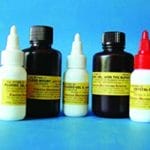Description
Leishman stain, also known as Leishman’s stain, is used in microscopy for staining blood smears. It is generally used to differentiate between and identify white blood cells, malaria parasites, and trypanosomas. It is based on a methanolic mixture of “polychromed” methylene blue (i.e. demethylated into various azures) and eosin. The methanolic stock solution is stable and also serves the purpose of directly fixing the smear eliminating a prefixing step. If a working solution is made by dilution with an aqueous buffer, the resulting mixture is very unstable and cannot be used for long. Leishman stain is named after its inventor, the Scottish pathologist William Boog Leishman. It is a version of the Romanowsky stain, and is thus similar to and partially replaceable by Giemsa stain, Jenner’s stain, and Wright’s stain.

![440px-Plasmodium_vivax_malaria[1] Leishman's Stain](https://efb7cwj5g4q.exactdn.com/wp-content/uploads/2020/03/440px-Plasmodium_vivax_malaria1.jpg?strip=all&lossy=1&sharp=1&ssl=1)





Avis
Il n’y a pas encore d’avis.